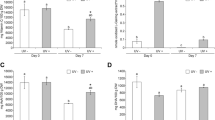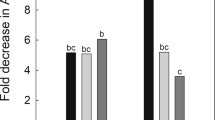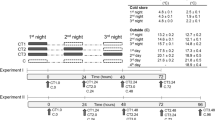Abstract
IT is well established that, in the absence of oxygen, many types of plant tissue produce ethanol. Under normal conditions, ethanol, other alcohols and various aldehydes are produced in small amounts by ripening fruits and other plant organs1–3. The question whether ethanol is metabolized by plant tissues has, on the other hand, been a source of controversy. In recent years Phillips4, working with barley seedlings, Wager5 with peas and Lowe and James6 with mature carrot disks have found no evidence for appreciable utilization of ethanol. However, Cossins and Turner7–9 showed that ethanol was consumed by the tissue in germinating peas and was converted initially to acetaldehyde and acetone, followed by the production of organic acids and amino-acids. Homogenates of a variety of germinating seeds were shown10, by redox indicator, to have alcohol dehydrogenase activity when the normal C2−, C3− and C4− aliphatic alcohols were added as substrates. Less activity was evident in the presence of the normal C1− or C5−, secondary C3− or iso-C4−, and tertiary C4− or C5− alcohols. Recently, Cossins and Beevers11 showed that carrot disks, corn and pea shoots, potato disks and castor bean endosperm rapidly metabolized carbon-14-labelled ethanol, while apple tissue consumed it very slowly. Their results suggested that acetyl coenzyme-A was derived from ethanol and converted to lipids, amino-acids, organic acids and sugars by known pathways.
This is a preview of subscription content, access via your institution
Access options
Subscribe to this journal
Receive 51 print issues and online access
$199.00 per year
only $3.90 per issue
Buy this article
- Purchase on Springer Link
- Instant access to full article PDF
Prices may be subject to local taxes which are calculated during checkout
Similar content being viewed by others
References
Meigh, D. F., in Modern Methods of Plant Analysis, edit. by Paech, K., and Tracey, M. V., 2, 403 (Springer-Verlag, Berlin, 1955).
Meigh, D. F., J. Sci. Food Agric., 7, 396 (1956).
Meigh, D. F., J. Sci. Food Agric., 8, 313 (1957).
Phillips, J. W., Amer. J. Bot., 34, 62 (1947).
Wager, H. G., New Phytol., 58, 68 (1959).
Lowe, C., and James, W. O., New Phytol., 59, 288 (1960).
Cossins, E. A., and Turner, E. R., Nature, 183, 1599 (1959).
Cossins, E. A., Nature, 194, 1095 (1962).
Cossins, E. A., and Turner, E. R., J. Exp. Bot., 14, 290 (1963).
Cossins, E. A., and Turner, E. R., Ann. Bot., 26, 591 (1962).
Cossins, E. A., and Beevers, H., Plant Physiol., 38, 375 (1963).
Schwartz, D. P., and Parks, O. W., Anal. Chem., 33, 1396 (1961).
White, P. R., The Cultivation of Animal and Plant Cells, second ed. (Ronald Press, New York, 1954).
Author information
Authors and Affiliations
Rights and permissions
About this article
Cite this article
MEIGH, D., PRATT, H. & COLE, C. Production of Carbonyl Compounds by Tomato Fruit Tissue in the Presence of Aliphatic Alcohols. Nature 211, 419–420 (1966). https://doi.org/10.1038/211419a0
Issue Date:
DOI: https://doi.org/10.1038/211419a0
Comments
By submitting a comment you agree to abide by our Terms and Community Guidelines. If you find something abusive or that does not comply with our terms or guidelines please flag it as inappropriate.



